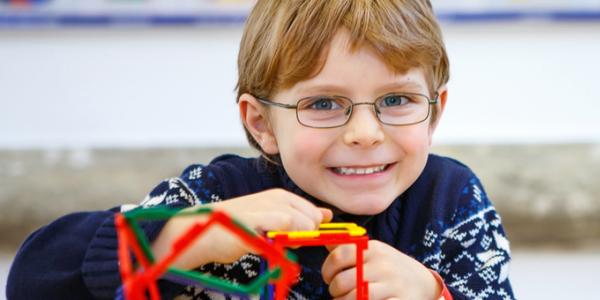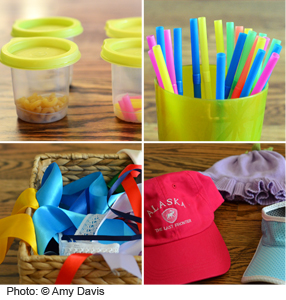Low-Cost Learning Materials for Infants and Toddlers

As an early childhood educator I wondered why parents buy children so many toys. I always felt that an excess of toys, especially the ones that made lots of noises, were unnecessary.
That is, until I became a parent.
As a new parent, I understand the temptation to run to the store to pick up something new that will hold my daughter’s interest long enough for me to cook dinner or fold laundry.
Determined to find low cost materials that interest my daughter and stimulate her development I started observing my daughter and looking around the house. I watched my daughter and paid attention to what interested her - belts, items she could shake and rattle, boxes, drawers full of interesting items, and more! Combining her interests with a little creativity, I've found several collections of household items that keep her learning and exploring.

Shakers – These are made from plastic food storage containers with secure lids. Each container has a different item in it to create an interesting noise: plastic straws cut into half inch pieces, water, pebbles, and sand. (Be sure to use containers that your child cannot open or seal with glue on the inside of the lid.)
Bracelets, bangles, and plastic cookie cutters– These are fun for little ones to slide on and off their wrist or to roll across the floor.
Straws – Infants enjoy pulling straws out of plastic containers. As they get older, they will put the straws in and take them out of containers. You can also link the straws together to create new ways to play.
Ribbons – These are good for exploring textures, dancing, or for decorating stuffed animals. (When offering ribbons to young children it is important to supervise closely to be sure the child does not mouth the ribbon or wrap it around her neck. Encourage your child to use the ribbons on toys and for twirling when dancing.)
Plastic jars with lids - These are fun for rolling across the floor, filling and dumping with items on a play mat, and screwing the lids on and off.
Pots, pans, and spoons – These are good pretend play experiences during dinner preparation as your child can mimic your actions.
Hats – These are fun to take on and off, put on a family member’s head, or for fastening and unfastening (example Velcro clasps).
With a little observation and ingenuity, we’ve found lots of great toys already right under our noses.
Note: When offering toys to young children be aware of choking hazards and make sure to supervise appropriately
Amy Davis is a former full-time teacher of young children and currently an Early Childhood Assistant Professor at Nashville State Community College. After teaching about young children all day, she gets to go home to one happy toddler and play!